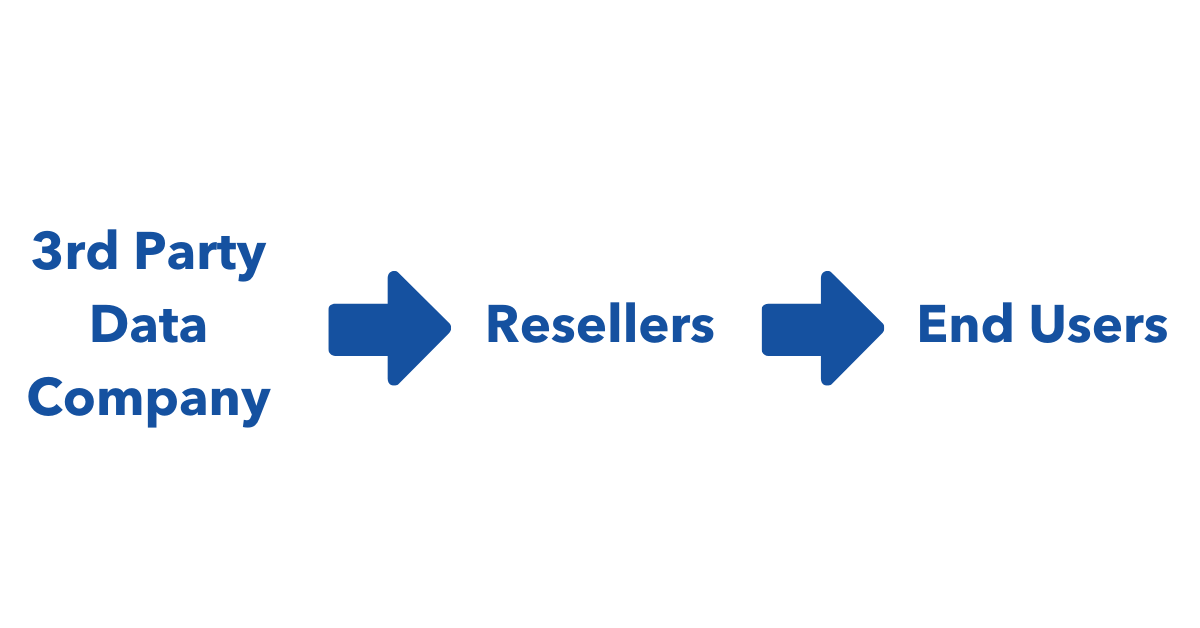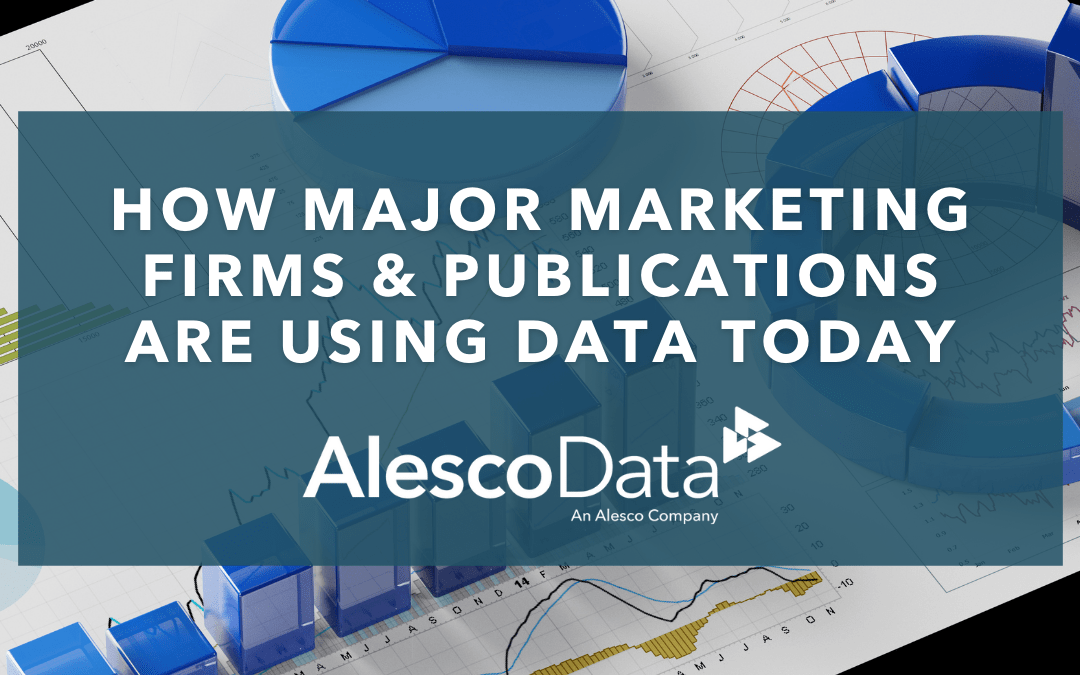Data companies are the ‘secret sauce’ marketers and publications have been using for decades. Both marketers and publications have been leveraging 3rd party data and machine learning algorithms (provided by big data companies) to enhance their own data and improve marketing campaigns. To put things into perspective: 97.2% of organizations are investing in big data and AI ( TechJury, 2020), and 88% of marketers surveyed use data obtained by third parties to enhance their understanding of each customer (Forbes, 2018). The question is: What type of data do most of these companies use and how are they using it?

What type of data do these companies use?
Most data used in marketing campaigns is personal data that people opt into or share willingly. The data is then shared with data companies for legal marketing use in compliance with privacy laws and regulations. This type of data typically includes first and last name, phone number, mailing address and/or email.
The Big Buzz On Data Reselling
Not all data purchased by marketing firms and publications is used by the company purchasing the data. Many companies resell the data to clients on an as-needed basis or will use the data to expand their client’s targeting capabilities. Data resellers or brokers buy data in bulk orders, and then resell it to their clients for a lower cost.

Who Buys Data from Resellers?
Almost every industry utilizes third-party data, including business owners, marketing companies, print shops, auto dealerships, and healthcare providers. Let’s take a more comprehensive look at some of these industries, and how they utilize third-party data.



The Automotive Industry
Many automotive marketing firms or dealerships use a combination of VIN data and general demographic data in their marketing campaigns. In automotive databases, VIN numbers match the Make, Model, and Year of the car. After a certain number of years, the car will need repairs, and with each repair, there is a trigger on the VIN number. Automotive companies then use this information and combine it with in-market data. The in-market data uses signals from searches, from the car owner visiting a store, to seeing if the owner’s income may have changed. Combining vehicle information and demographics can help determine when a car owner is likely to sell or trade their current vehicle for a new one. In addition to that combination, companies can pull records on cars that have leases expiring soon, providing the dealership with a prime target market for either trying to get their contacts to sign a new lease, or extend their existing one. These are just a few ways data is used in the automotive industry – click here to learn more!
The types of creative used by the automotive industry include direct mail deals that are used to entice residents to come take a look at their inventory. A lot of the creative used will include deals on special rate leases on new cars, contests, and matched down payments the dealership will make on financed purchases.
The Insurance Industry
Most insurance companies looking to target individuals will target potential buyers by their age, homeownership, and automobile ownership. They also purchase B2b data lists which target certain industries, new businesses opening up, and employee size. Each data purchase is based on the type of insurance they are trying to sell. Many times the insurance companies will leverage their selects with a machine learning algorithm, to target those most likely to convert into customers. Insurance companies send out emails to their target audience, direct mail, and will then usually follow up their campaigns with a phone call.
Small Businesses
Restaurants, plumbers, boutique shops, realtors, and other local businesses will use residential lists provided by the reseller, to target certain zip codes in their area. They will usually send out postcards, mailers, and coupons to their target audience, not only targeting by zip code but also drilling down their audience by demographics such as age, homeownership status, gender, and more. The creative will vary based on the company and the region they are advertising in. However, the bulk of ads from small businesses are about any offers they are having that month and are geared toward bringing people into their businesses.
Using Data to Improve Marketing Outreach
Sometimes prospects in a target market aren’t ready to purchase, or aren’t interested in buying specific products or services. Leaders in the marketing and publishing industries understand this, and they understand that their future consumers rely on the message being delivered on time and to the appropriate person. Their industries are focused on reaching new or existing businesses in search of more leads and customers. The data used to do this is a bit more complex and is typically a combination of different data services, used to drill down the target market to select fewer potential customers.
Data Services Used By Resellers & End Users
Data Appends
Sometimes a business only has partial data – they may only have a phone number and/or a contact name, but missing an email address. A data append helps fill in the missing gaps in your records. The process takes your current data and runs it against several trusted third party databases. This returns an enhanced data set that includes any missing information requested by the business or customer.
Data Validations
Many companies face the issue of having outdated data. Data validation analyzes that information, finds those contacts and removes them from your contacts, this way a company can optimize its marketing efforts. This option is great for companies deploying emails on a regular basis and are trying to avoid high bounce rates, opt-outs, and spam traps.

Common Marketing Campaign Strategies
Omnichannel marketing has become one of the most essential parts of any marketing strategy today. The idea is that any company can combine its offline and online marketing efforts, to increase brand recognition and increase sales. Marketing agencies and publications use data to improve omnichannel marketing for themselves and their clients. An omnichannel marketing campaign allows a company to take full advantage of multiple marketing channels to create a cohesive campaign that maximizes outreach.
New Startups
Data is perfect for companies that are just starting out and looking to increase brand awareness. With so many demographic selects and consumer data, it’s easy for startup companies to get a narrow list of their target market. Additionally, B2B data is readily available for any new startup looking to target potential prospects. A well thought out marketing plan that combines direct mail, digital advertising and email marketing can make all the difference during the first year of business.
Established Brands
Big brands often have a large database of customers, but want more insight on their current market. Their campaigns begin with Customer Insight & Analysis Data, which takes a company’s current customer base, finds similarities in the customers, then finds new customers that are similar to their current database. Combining this new audience with the existing audience and sending out direct mail, digital ads, and emails are great ways to maintain customer retention while getting new customers to purchase.
Download Your Free Copy!
If you are struggling with disappointing results from your direct mail programs, machine learning could be your ideal solution. Learn how this type of artificial intelligence is transforming our client’s marketing programs.
Machine Learning Download

